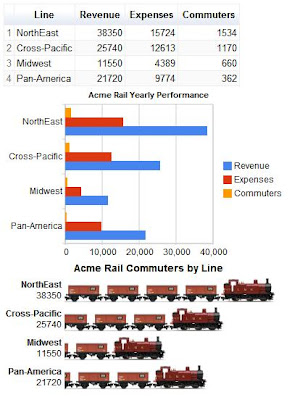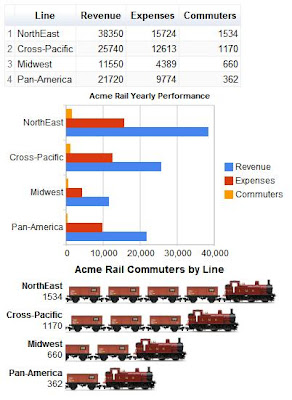DataView Makes Working with Visualizations Even Easier
By Yaniv
Shuba and Nir Bar-Lev, Google Visualization
TeamVisualizations are usually nifty, small pieces of code
that make our data come alive. In order to live in peace on the web, they need to be
streamlined and compact.
At times, these visualization applications are a
product of a creative designer who publishes their work for free for all of us to use. Often
these designers do not have the time and resources to deal with data input
structures.
Therefore, when integrating with a specific visualization, we
often need to format the
DataTable just right, so it fits the way the visualization expects to
get the data. Say as an example, a first column needs to be of type date, the second a number
and the third a text comment. What if our DataTable is not in that exact format? What if we
want to create several visualizations over the same data source? To date this required
manipulating the DataTable to fit the particular visualization and made the API a bit less
flexible.
To make fitting data to the visualization even easier and
simpler, and the Visualization API even more flexible, we've borrowed from the well-known SQL
concept of Views and created our own
DataView. Today, with Google Visualization's DataView you can reorder
columns and "hide" a column such that the view includes only the columns you need to
visualize. And, the DataView stays fully synchronized with the DataTable at all times, so any
change to the underlying DataTable is reflected in the DataView.
Let's see
a simple example that demonstrates this.
The following code creates three
charts from a DataTable. The data displayed is yearly results for the imaginary Acme Rail
company. We display a table, a bar chart and a BarsOfStuff chart. The BarsOfStuff chart is
used because we are showing data for Acme Rail, and we thought it'd be cool to use the little
trains in the chart:
<html>
<head>
<script type="text/javascript"
src="http://www.google.com/jsapi"></script>
<link
rel="stylesheet" type="text/css" href="http://visapi-
gadgets.googlecode.com/svn/trunk/barsofstuff/bos.css"/>
<script
type="text/javascript" src="http://visapi-
gadgets.googlecode.com/svn/trunk/barsofstuff/bos.js"></script>
<script type="text/javascript">
google.load("visualization",
"1", {packages:["barchart","table"]});
google.setOnLoadCallback(drawData);
// Initialize the DataTable
function drawData() {
var data = new google.visualization.DataTable();
data.addColumn('string', 'Line');
data.addColumn('number', 'Revenue');
data.addColumn('number', 'Expenses');
data.addColumn('number',
'Commuters');
data.addRows(4);
data.setValue(0, 0, 'NorthEast');
data.setValue(0, 1, 38350);
data.setValue(0, 2, 15724);
data.setValue(0, 3, 1534);
data.setValue(1, 0, 'Cross-Pacific');
data.setValue(1, 1, 25740);
data.setValue(1, 2, 12613);
data.setValue(1, 3, 1170);
data.setValue(2, 0, 'Midwest');
data.setValue(2, 1, 11550);
data.setValue(2, 2, 4389);
data.setValue(2, 3, 660);
data.setValue(3, 0, 'Pan-America');
data.setValue(3, 1, 21720);
data.setValue(3, 2, 9774);
data.setValue(3, 3, 362);
//Draw the charts
var table =
new google.visualization.Table(document.getElementById('table_div'));
table.draw(data, {showRowNumber: true});
var chart = new
google.visualization.BarChart(document.getElementById('chart_div'));
chart.draw(data, {width: 400, height: 240, is3D: false, title: 'Acme Rail Yearly
Performance'});
var stuffoptions = {title: 'Acme Rail Commuters by
Line'};
var stuffchart = new
BarsOfStuff(document.getElementById('stuff_div'))
stuffchart.draw(data,
stuffoptions);
}
</script>
</head>
<body>
<div
id="table_div"></div>
<div
id="chart_div"></div>
<div id="stuff_div" style="width:
400px"></div>
</body>
</html>
The result looks like this:

The problem is that BarsOfStuff is a cool chart, but it is very simple. It can only
accept a single data series in the format: [Series Title; Series
Value].
Notice that right now the chart compares
revenue
per rail line, but we wanted it to display the number of
commuters per line
(as the title suggests).
How can we fix this? With DataView it is a simple
matter of adding two lines of code and pointing the BarsOfStuff chart to the DataView instead
of the DataTable. We add:
var view = new
google.visualization.DataView(data);
view.setColumns([0,3]);
And initialize the BarsOfStuff chart with the DataView:
stuffchart.draw(view, stuffoptions);
And we get:

Voila! The BarsOfStuff chart now shows the data we wanted it to visualize - commuters per
rail line.
Yet another new feature to make developing complex dashboards
with Google Visualization even easier is the
clone() method, used to clone a DataTable instead of constructing a new
copy from scratch.
We're working on making the DataView even more powerful,
and of-course, working on other features and additions to the Visualization
platform.
For more information on
Google Visualization,
check out our developer
documentation
pages.
Happy visualizing!

